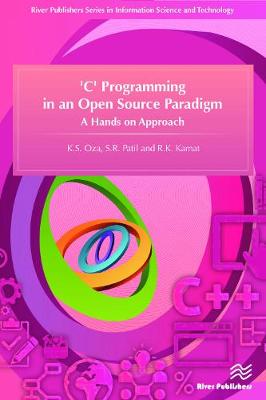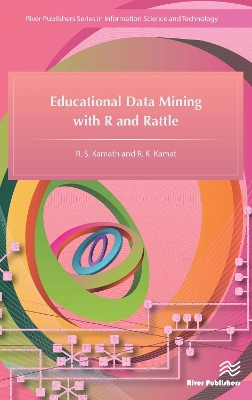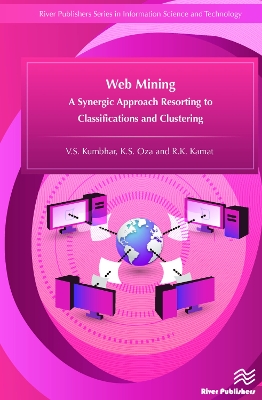River Publishers Series in Information Science and Technology
3 total works
'C' Programming in an Open Source Paradigm
by K. S. Oza, S. R. Patil, and R K Kamat
Published 26 October 2015
Over the period of last few decades, the ‘C’ language has become an icon for computer programmers. The field of computer science has undergone tremendous change, and the rate of obsolescence of concepts, programming platforms, tools and utilities is extremely high. However, in spite of such vast changes, the only thing that has retained its stability is the ‘C’ language. Even today, millions of students, hobbyists and professional programmers enjoy the sturdiness, reliability and user friendliness of the ‘C’ language. Today ‘C’ enjoys the undisputable recognition in the computing paradigm for diversified applications, from the basic programming, microcontrollers, and spreadsheets to system programming.
In this book, most of the usual theoretical features have been skipped, for these have been widely published in previous books. Rather than introducing the underpinning theory, the authors approach has been “learning-through-doing”, which is one that often appeals to programmers. Theory is followed by practical implementation, and in this way the book will cover programming aspects in a self-tutor manner providing an excellent overview, from basic to advance programming.
Topics discussed include:
• GCC interface
• First time ‘C’ User
• Decision and looping structures
• Arrays and pointers
• Functions, structures and union
• Linear data structures
In this book, most of the usual theoretical features have been skipped, for these have been widely published in previous books. Rather than introducing the underpinning theory, the authors approach has been “learning-through-doing”, which is one that often appeals to programmers. Theory is followed by practical implementation, and in this way the book will cover programming aspects in a self-tutor manner providing an excellent overview, from basic to advance programming.
Topics discussed include:
• GCC interface
• First time ‘C’ User
• Decision and looping structures
• Arrays and pointers
• Functions, structures and union
• Linear data structures
Educational Data Mining (EDM) is one of the emerging fields in the pedagogy and andragogy paradigm, it concerns the techniques which research data coming from the educational domain. EDM is a promising discipline which has an imperative impact on predicting students' academic performance. It includes the transformation of existing, and the innovation of new approaches derived from multidisciplinary spheres of influence such as statistics, machine learning, psychometrics, scientific computing etc.
An archetype that is covered in this book is that of learning by example. The intention is that reader will easily be able to replicate the given examples and then adapt them to suit their own needs of teaching-learning. The content of the book is based on the research work undertaken by the authors on the theme "Mining of Educational Data for the Analysis and Prediction of Students' Academic Performance". The basic know-how presented in this book can be treated as guide for educational data mining implementation using R and Rattle open source data mining tools. .
Technical topics discussed in the book include:
• Emerging Research Directions in Educational Data Mining
• Design Aspects and Developmental Framework of the System
• Model Development - Building Classifiers
• Educational Data Analysis: Clustering Approach
An archetype that is covered in this book is that of learning by example. The intention is that reader will easily be able to replicate the given examples and then adapt them to suit their own needs of teaching-learning. The content of the book is based on the research work undertaken by the authors on the theme "Mining of Educational Data for the Analysis and Prediction of Students' Academic Performance". The basic know-how presented in this book can be treated as guide for educational data mining implementation using R and Rattle open source data mining tools. .
Technical topics discussed in the book include:
• Emerging Research Directions in Educational Data Mining
• Design Aspects and Developmental Framework of the System
• Model Development - Building Classifiers
• Educational Data Analysis: Clustering Approach
Web mining is the application of data mining strategies to excerpt learning from web information, i.e. web content, web structure, and web usage data. With the emergence of the web as the predominant and converging platform for communication, business and scholastic information dissemination, especially in the last five years, there are ever increasing research groups working on different aspects of web mining mainly in three directions. These are: mining of web content, web structure and web usage. In this context there are good number of frameworks and benchmarks related to the metrics of the websites which is certainly weighty for B2B, B2C and in general in any e-commerce paradigm. Owing to the popularity of this topic there are few books in the market, dealing more on such performance metrics and other related issues. This book, however, omits all such routine topics and lays more emphasis on the classification and clustering aspects of the websites in order to come out with the true perception of the websites in light of its usability.In nutshell, Web Mining: A Synergic Approach Resorting to Classifications and Clustering showcases an effective methodology for classification and clustering of web sites from their usability point of view. While the clustering and classification is accomplished by using an open source tool WEKA, the basic dataset for the selected websites has been emanated by using a free tool site-analyzer. As a case study, several commercial websites have been analyzed. The dataset preparation using site-analyzer and classification through WEKA by embedding different algorithms is one of the unique selling points of this book. This text projects a complete spectrum of web mining from its very inception through data mining and takes the reader up to the application level. Salient features of the book include: Literature review of research work in the area of web miningBusiness websites domain researched, and data collected using site-analyzer toolAccessibility, design, text, multimedia, and networking are assessedDatasets are filtered further by selecting vital attributes which are Search Engine Optimized for processing using the Weka attributed toolDataset with labels have been classified using J48, RBFNetwork, NaïveBayes, and SMO techniques using WekaA comparative analysis of all classifiers is reportedCommercial applications for improving website performance based on SEO is given


